英语翻译的基本常识解析
大学英语笔译知识点总结
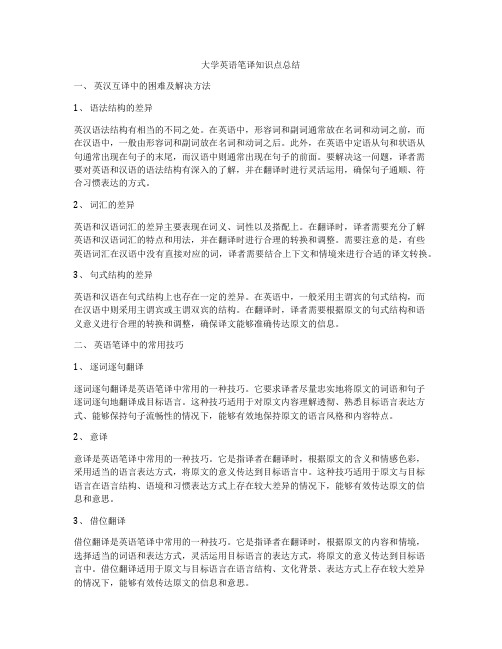
大学英语笔译知识点总结一、英汉互译中的困难及解决方法1、语法结构的差异英汉语法结构有相当的不同之处。
在英语中,形容词和副词通常放在名词和动词之前,而在汉语中,一般由形容词和副词放在名词和动词之后。
此外,在英语中定语从句和状语从句通常出现在句子的末尾,而汉语中则通常出现在句子的前面。
要解决这一问题,译者需要对英语和汉语的语法结构有深入的了解,并在翻译时进行灵活运用,确保句子通顺、符合习惯表达的方式。
2、词汇的差异英语和汉语词汇的差异主要表现在词义、词性以及搭配上。
在翻译时,译者需要充分了解英语和汉语词汇的特点和用法,并在翻译时进行合理的转换和调整。
需要注意的是,有些英语词汇在汉语中没有直接对应的词,译者需要结合上下文和情境来进行合适的译文转换。
3、句式结构的差异英语和汉语在句式结构上也存在一定的差异。
在英语中,一般采用主谓宾的句式结构,而在汉语中则采用主谓宾或主谓双宾的结构。
在翻译时,译者需要根据原文的句式结构和语义意义进行合理的转换和调整,确保译文能够准确传达原文的信息。
二、英语笔译中的常用技巧1、逐词逐句翻译逐词逐句翻译是英语笔译中常用的一种技巧。
它要求译者尽量忠实地将原文的词语和句子逐词逐句地翻译成目标语言。
这种技巧适用于对原文内容理解透彻、熟悉目标语言表达方式、能够保持句子流畅性的情况下,能够有效地保持原文的语言风格和内容特点。
2、意译意译是英语笔译中常用的一种技巧。
它是指译者在翻译时,根据原文的含义和情感色彩,采用适当的语言表达方式,将原文的意义传达到目标语言中。
这种技巧适用于原文与目标语言在语言结构、语境和习惯表达方式上存在较大差异的情况下,能够有效传达原文的信息和意思。
3、借位翻译借位翻译是英语笔译中常用的一种技巧。
它是指译者在翻译时,根据原文的内容和情境,选择适当的词语和表达方式,灵活运用目标语言的表达方式,将原文的意义传达到目标语言中。
借位翻译适用于原文与目标语言在语言结构、文化背景、表达方式上存在较大差异的情况下,能够有效传达原文的信息和意思。
英语翻译的基本常识解析
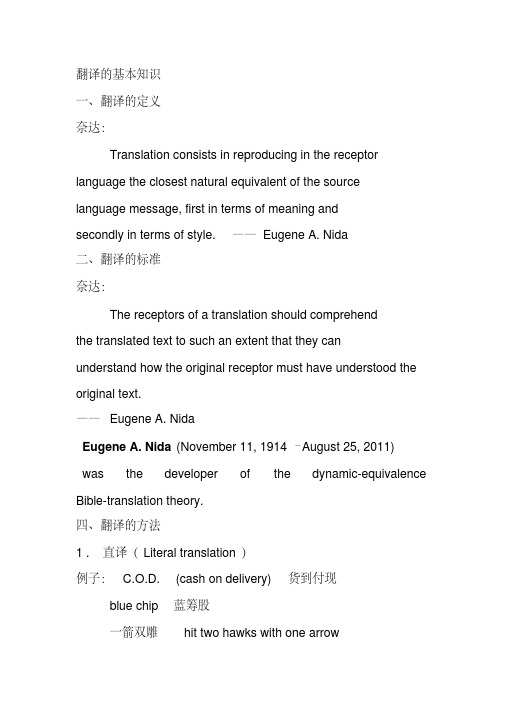
翻译的基本知识一、翻译的定义奈达:Translation consists in reproducing in the receptor language the closest natural equivalent of the sourcelanguage message, first in terms of meaning andsecondly in terms of style. —— Eugene A. Nida二、翻译的标准奈达:The receptors of a translation should comprehendthe translated text to such an extent that they canunderstand how the original receptor must have understood the original text.——Eugene A. NidaEugene A. Nida (November 11, 1914 – August 25, 2011)was the developer of the dynamic-equivalence Bible-translation theory.四、翻译的方法1 . 直译(Literal translation)例子: C.O.D. (cash on delivery) 货到付现blue chip 蓝筹股一箭双雕hit two hawks with one arrow意译(Free translation)例子:WPA 水渍blue chip 绩优股一箭双雕kill two birds with one stone一、广告的定义Advertising is the non-personal communication ofinformation usually paid for and usually persuasive innature about products, services or ideas by identifiedsponsors through the various media.—— American Marketing Association二、广告的分类1.理性广告(Rational ads)情感广告(Emotional ads)三、广告的组成部分1.Headline Subhead Text (body) Logo slogan(麦当劳)我就喜欢!I’m lovin’ it!Good to the last drop. (Maxwell coffee)滴滴香浓,意犹未尽。
英语翻译十大技巧

英语翻译十大技巧在今天的全球化时代,英语已经成为了一种全球通用语言,无论是在学校、工作场所还是日常生活中,我们都需要使用英语。
而对于许多非英语母语的人来说,翻译成英语可能是一个具有挑战性的任务。
本文将介绍英语翻译的十大技巧,帮助您更好地应对这一任务。
一、理解原文在开始翻译之前,首先要确保对原文有一个清晰的理解。
仔细阅读原文,理解其中的意思、语境以及作者的写作目的。
只有通过深入理解原文,我们才能更好地传达原文中的信息。
二、根据上下文翻译时常我们会遇到一些具有多义性的词语,在翻译时需要根据上下文来进行选择合适的含义。
通过仔细分析句子所处的语境,我们可以更准确地翻译出这些词语的意思。
三、保持简洁明了英语一直以来都以简洁明了著称,翻译时也要尽量保持这种特点。
避免使用过于繁琐的句子结构和冗长的表达方式,保持句子的简洁性,能够使读者更容易理解所要传达的意思。
四、注意语法和拼写正确的语法和拼写是英语翻译中的关键。
犯下语法和拼写错误可能会导致误解和歧义。
要牢记英语的基本语法规则,仔细检查所翻译的内容,确保语法和拼写的正确性。
五、避免直译直译是一个常见的翻译错误。
有时,一个短语或句子在英语中的表达方式与原文完全不同。
在翻译时,应尽量避免直译,而是根据英语的表达习惯和习语来传达原文的含义。
六、了解文化差异英语的使用和表达方式在不同的文化背景下可能会有所不同。
在翻译时,要注意原文所处的文化背景,并尽可能将这种文化差异传达到译文中。
这样可以使译文更贴近原文的意思,同时也更容易被目标读者所理解。
七、重视语气和语调语气和语调在英语中承载了很多信息。
在翻译时,要尽量保留原文中的语气和语调,使译文更贴合原文的情感色彩。
这样可以使读者更加有身临其境的感受,更好地理解原文的意思。
八、遵循译者的道德准则作为翻译者,我们应该遵循译者的道德准则。
这包括尊重原文作者的原意,不添油加醋地篡改原文的含义,以及对译文进行客观和公正的表达。
我们应该始终忠实于原文,并尽力传达原文所要表达的意思。
英语基础体系教程(精)-第12章 翻译知识

③转折关系:对同一事物进行对比性描述时,常代表转折含义,译为“而, 却,反之,相反”。
e.g. I was received by a little vibrant lady in her 70’s, grey-haired and beautiful. 可译为:接待我的是一位身材娇小而又神采奕奕的女士。虽然这位女 士已年逾古稀,满头银发,但却风韵犹存。
Step3: Checking 检查:漏译/错译(观点等)
(二)Principles 原则
1、增词法(结构;语义) 结构上:时态,数,不同的句子结构等 e.g. We are taking English class now. 我们现在正在上英文课。
because, although,if 等这些连接词在英文中不能配对出现,因为英 文中可以有多个从句,但只能有一个主句。
⑤双重否定=肯定 e.g. There is nothing unusual here. 这儿一切正常。
No pains, no gains. 一分耕耘一分收获。
There is no grammatical rule without exceptions. 凡语法规则都有例外。 There is no smoke without fire. 无风不起浪。(事出有因。)
④词义转换 e.g. Jack was a fixture of Real Madrid’s games in his
schooldays. 杰克在学生时代是皇家马德里队的忠实球迷,场场必到。 Beckham has become a fixture of Real Madrid’s games since he joined this team. 自从贝克汉姆加入皇家马德里队,他就成为了这支球队的绝对主力,场场 首发。 We do chicken right. 我们是烹鸡专家。
专业英语翻译基本知识
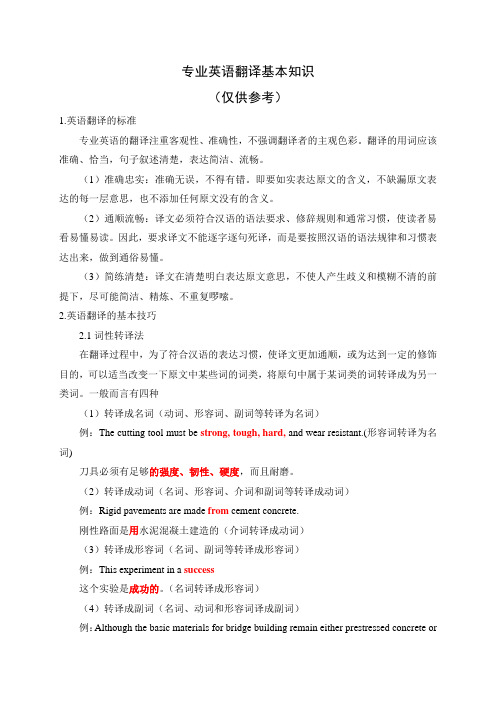
专业英语翻译基本知识(仅供参考)1.英语翻译的标准专业英语的翻译注重客观性、准确性,不强调翻译者的主观色彩。
翻译的用词应该准确、恰当,句子叙述清楚,表达简洁、流畅。
(1)准确忠实:准确无误,不得有错。
即要如实表达原文的含义,不缺漏原文表达的每一层意思,也不添加任何原文没有的含义。
(2)通顺流畅:译文必须符合汉语的语法要求、修辞规则和通常习惯,使读者易看易懂易读。
因此,要求译文不能逐字逐句死译,而是要按照汉语的语法规律和习惯表达出来,做到通俗易懂。
(3)简练清楚:译文在清楚明白表达原文意思,不使人产生歧义和模糊不清的前提下,尽可能简洁、精炼、不重复啰嗦。
2.英语翻译的基本技巧2.1词性转译法在翻译过程中,为了符合汉语的表达习惯,使译文更加通顺,或为达到一定的修饰目的,可以适当改变一下原文中某些词的词类,将原句中属于某词类的词转译成为另一类词。
一般而言有四种(1)转译成名词(动词、形容词、副词等转译为名词)例:The cutting tool must be strong, tough, hard, and wear resistant.(形容词转译为名词)刀具必须有足够的强度、韧性、硬度,而且耐磨。
(2)转译成动词(名词、形容词、介词和副词等转译成动词)例:Rigid pavements are made from cement concrete.刚性路面是用水泥混凝土建造的(介词转译成动词)(3)转译成形容词(名词、副词等转译成形容词)例:This experiment in a success这个实验是成功的。
(名词转译成形容词)(4)转译成副词(名词、动词和形容词译成副词)例:Although the basic materials for bridge building remain either prestressed concrete orsteel, there have been some recent changes尽管建桥的基本材料仍然是预应力混凝土或钢材,但近来已经有些变化了。
初中英语知识点归纳常见的翻译技巧与方法
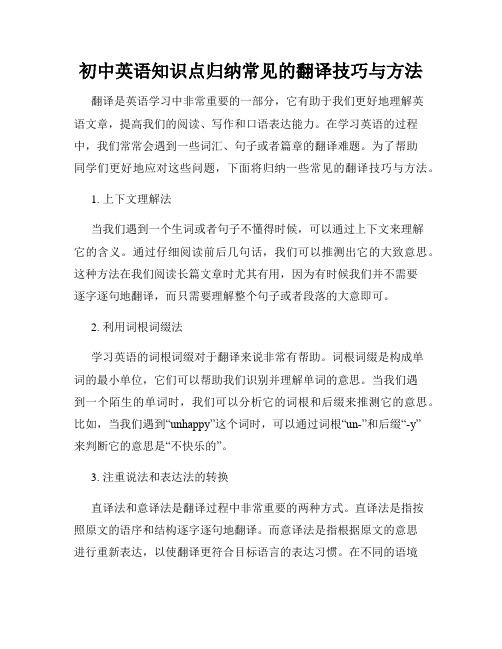
初中英语知识点归纳常见的翻译技巧与方法翻译是英语学习中非常重要的一部分,它有助于我们更好地理解英语文章,提高我们的阅读、写作和口语表达能力。
在学习英语的过程中,我们常常会遇到一些词汇、句子或者篇章的翻译难题。
为了帮助同学们更好地应对这些问题,下面将归纳一些常见的翻译技巧与方法。
1. 上下文理解法当我们遇到一个生词或者句子不懂得时候,可以通过上下文来理解它的含义。
通过仔细阅读前后几句话,我们可以推测出它的大致意思。
这种方法在我们阅读长篇文章时尤其有用,因为有时候我们并不需要逐字逐句地翻译,而只需要理解整个句子或者段落的大意即可。
2. 利用词根词缀法学习英语的词根词缀对于翻译来说非常有帮助。
词根词缀是构成单词的最小单位,它们可以帮助我们识别并理解单词的意思。
当我们遇到一个陌生的单词时,我们可以分析它的词根和后缀来推测它的意思。
比如,当我们遇到“unhappy”这个词时,可以通过词根“un-”和后缀“-y”来判断它的意思是“不快乐的”。
3. 注重说法和表达法的转换直译法和意译法是翻译过程中非常重要的两种方式。
直译法是指按照原文的语序和结构逐字逐句地翻译。
而意译法是指根据原文的意思进行重新表达,以使翻译更符合目标语言的表达习惯。
在不同的语境中,我们需要灵活运用这两种翻译策略,以便更好地表达出原文的意义。
4. 注意语法结构和时态变化英语与汉语在语法结构和时态变化上有很大的差异。
为了准确地翻译句子,我们需要了解并掌握英语的语法规则和时态变化。
比如,当我们翻译一句过去进行时的句子时,我们需要将动词变为过去进行时态,加上相应的助动词和时态标志词。
5. 预习和复习课文预习和复习课文是我们学习英语的基本功课。
在课堂上,老师通常会引导我们对课文进行预习和复习。
这个环节对于翻译技巧的提高非常关键。
通过预习和复习课文,我们可以更好地理解课文的内容和结构,从而更准确地翻译课文。
总结起来,翻译是英语学习中不可或缺的一部分。
通过灵活应用上下文理解法、利用词根词缀法、注重说法和表达法的转换、注意语法结构和时态变化以及预习和复习课文等技巧和方法,我们可以更好地进行英语翻译,提高我们的英语水平。
汉英翻译基础知识(精选.)甄选

汉英翻译基础知识(精选.)汉英翻译基础知识2.1 汉英翻译与文化2.2 中英思维方式对比2.3 汉英语言对比2.4 汉译英优美句型2.5 汉语词组英译2.6 汉语修饰语词组的英译处理2.7 汉译英句子的难点2.1 汉英翻译与文化⏹2.1.1 文化的定义与分类著名翻译理论家尤金.奈达定义为“某一人群及其生存环境中所特有的某种活动、思想及其在物体和活动中所表现出来的物质形式的总和”。
英国人类学家泰勒给出了“一个复合的整体,其中包括知识、信仰、艺术、法律、道德、风俗以及作为社会成员而获得的任何其他的能力和习惯”的定义。
文化是人类在社会历史发展过程中所创造的物质财富和精神财富的总和。
(《现代汉语字典》第一条定义)⏹文化的分类⏹从地域分,有本土文化和外来文化⏹从时间分,由原始文化、奴隶制文化、封建文化、资本主义文化、社会主义文化等;⏹从宗教信仰分,有佛教文化、道教文化、基督教文化、伊斯兰教文化等;2.1.2 文化、语言与汉英翻译的关系一、自然条件的差异“等闲识得东风面,万紫千红总是春”等。
Biting east winds; a piercing east wind;*花钱如流水waste money like water*水中捞月fish in the air*另有要事have other fish to fly*牛饮drink like a fish*一个冷漠的人a cold fish*凡能到手的都要all is fish that comes to one’s net⏹二、习俗的差异* a lucky dogLove me, love my dogEvery dog has his day*红色,热情兴旺吉利;暴力、流血和战争David Hawkes的《红楼梦》The story of the Stone2.2 中英思维方式对比⏹2.2.1 中国人注重伦理(ethics);英美人注重认知(congnition)“以儒家为代表的先哲对世界的认识主要出于对现实政治和伦理道德的关注”。
专业英语翻译基础知识

专业英语翻译基础知识专业英语翻译是一门需要掌握一定基础知识的技能。
在进行专业英语翻译工作之前,掌握以下几个方面的知识能够帮助翻译者更好地完成任务。
一、语言基础知识1. 词汇:掌握丰富的词汇量,包括专业领域的术语。
翻译时需注意词汇的准确用法和语义的表达。
2. 语法:熟悉英语的基本语法规则和句型结构,以确保译文的语法正确性。
3. 语用学:了解语言在不同语境中的使用方式,如文化差异和语气表达等因素对翻译的影响。
二、领域知识1. 专业词汇:对于特定领域的专业词汇需要有充分的了解,包括科技、法律、医学、商务等领域的术语。
通过学习和积累,确保准确翻译相关的专业术语。
2. 背景知识:对于所翻译内容的行业或领域,了解相关的背景知识和专业常识,以便更好地理解并准确传达原文的含义。
三、翻译技巧1. 翻译思维:培养灵活的思维方式,在翻译过程中进行准确的语言转换,将原文的意思完整传达出来。
2. 模糊表达处理:若原文中存在模糊表达或歧义,翻译时需要合理处理,通过上下文推断或咨询领域专家等方式准确解读。
3. 文体转换:不同类型的文本需要采用不同的翻译风格,如科技报告使用正式、专业的语言,而广告宣传语则需要更生动、富有创意。
四、工具运用1. 电子词典和翻译软件:利用专业的电子词典和翻译软件,能够提供准确的词义解释和翻译结果,提高翻译效率和准确性。
2. 双语资料收集:积累相关领域的双语资料,通过查阅、对比并学习翻译范例,提升自己的翻译水平。
总之,专业英语翻译需要具备扎实的语言基础知识、相关领域的专业知识和翻译技巧,同时善于运用翻译工具,并不断进行学习和积累,提高翻译水平。
只有全面掌握这些基础知识,才能够胜任专业英语翻译工作。
英语翻译的知识点
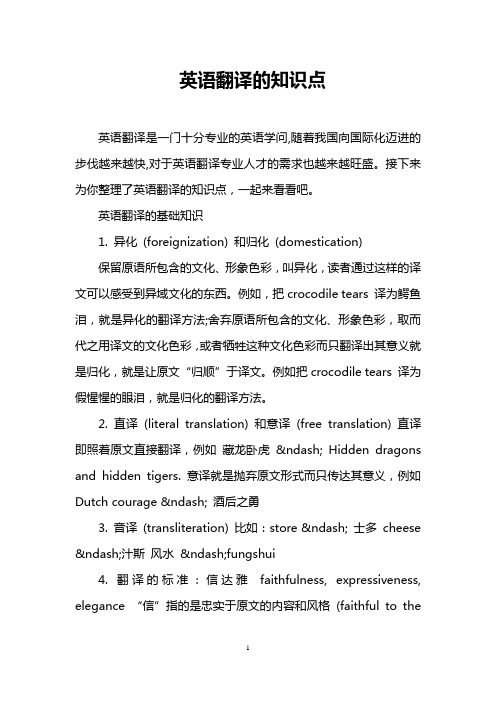
英语翻译的知识点英语翻译是一门十分专业的英语学问,随着我国向国际化迈进的步伐越来越快,对于英语翻译专业人才的需求也越来越旺盛。
接下来为你整理了英语翻译的知识点,一起来看看吧。
英语翻译的基础知识1. 异化(foreignization) 和归化(domestication)保留原语所包含的文化、形象色彩,叫异化,读者通过这样的译文可以感受到异域文化的东西。
例如,把crocodile tears 译为鳄鱼泪,就是异化的翻译方法;舍弃原语所包含的文化、形象色彩,取而代之用译文的文化色彩,或者牺牲这种文化色彩而只翻译出其意义就是归化,就是让原文“归顺”于译文。
例如把crocodile tears 译为假惺惺的眼泪,就是归化的翻译方法。
2. 直译(literal translation) 和意译(free translation) 直译即照着原文直接翻译,例如藏龙卧虎– Hidden dragons and hidden tigers. 意译就是抛弃原文形式而只传达其意义,例如Dutch courage – 酒后之勇3. 音译(transliteration) 比如:store – 士多cheese –汁斯风水–fungshui4. 翻译的标准:信达雅faithfulness, expressiveness, elegance “信”指的是忠实于原文的内容和风格(faithful to thecontent and style of the source text;“达”指的是译文语言流畅自然而不生硬阻滞(the translation or target text should be natural and expressive);“雅”指的是译文译文语言风格尽可能贴近原文风格。
5. 词类的转化conversion :名词动词形容词副词根据表达需要,在翻译中,往往需要进行词类的转化,此外,还包括抽象与具体的转化。
翻译概论知识点总结
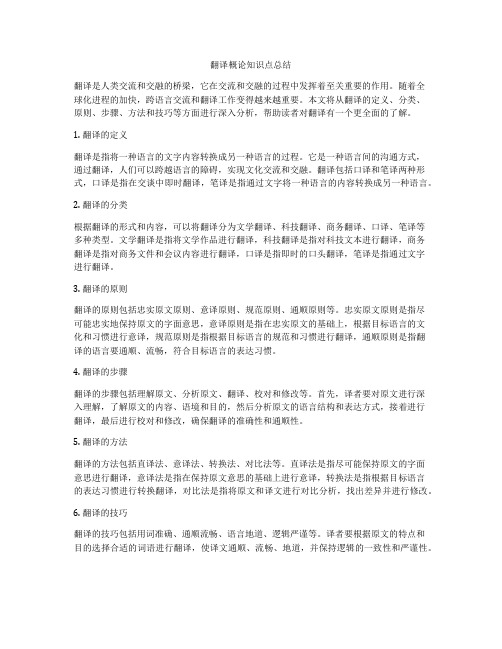
翻译概论知识点总结翻译是人类交流和交融的桥梁,它在交流和交融的过程中发挥着至关重要的作用。
随着全球化进程的加快,跨语言交流和翻译工作变得越来越重要。
本文将从翻译的定义、分类、原则、步骤、方法和技巧等方面进行深入分析,帮助读者对翻译有一个更全面的了解。
1. 翻译的定义翻译是指将一种语言的文字内容转换成另一种语言的过程。
它是一种语言间的沟通方式,通过翻译,人们可以跨越语言的障碍,实现文化交流和交融。
翻译包括口译和笔译两种形式,口译是指在交谈中即时翻译,笔译是指通过文字将一种语言的内容转换成另一种语言。
2. 翻译的分类根据翻译的形式和内容,可以将翻译分为文学翻译、科技翻译、商务翻译、口译、笔译等多种类型。
文学翻译是指将文学作品进行翻译,科技翻译是指对科技文本进行翻译,商务翻译是指对商务文件和会议内容进行翻译,口译是指即时的口头翻译,笔译是指通过文字进行翻译。
3. 翻译的原则翻译的原则包括忠实原文原则、意译原则、规范原则、通顺原则等。
忠实原文原则是指尽可能忠实地保持原文的字面意思,意译原则是指在忠实原文的基础上,根据目标语言的文化和习惯进行意译,规范原则是指根据目标语言的规范和习惯进行翻译,通顺原则是指翻译的语言要通顺、流畅,符合目标语言的表达习惯。
4. 翻译的步骤翻译的步骤包括理解原文、分析原文、翻译、校对和修改等。
首先,译者要对原文进行深入理解,了解原文的内容、语境和目的,然后分析原文的语言结构和表达方式,接着进行翻译,最后进行校对和修改,确保翻译的准确性和通顺性。
5. 翻译的方法翻译的方法包括直译法、意译法、转换法、对比法等。
直译法是指尽可能保持原文的字面意思进行翻译,意译法是指在保持原文意思的基础上进行意译,转换法是指根据目标语言的表达习惯进行转换翻译,对比法是指将原文和译文进行对比分析,找出差异并进行修改。
6. 翻译的技巧翻译的技巧包括用词准确、通顺流畅、语言地道、逻辑严谨等。
译者要根据原文的特点和目的选择合适的词语进行翻译,使译文通顺、流畅、地道,并保持逻辑的一致性和严谨性。
英语翻译的方法及技巧

英语翻译的方法及技巧语言的互相翻译不但有利于各国文化的交流,更有利于语言的发展。
下面由店铺为大家整理的关于英语翻译方法及技巧的一些内容,希望大家喜欢!英语翻译方法和技巧归纳一、词汇方面㈠.词义选择大多数英语词汇是多义的,翻译时必须选择正确的词义。
词义选择的方法有三:根据上下文和词的搭配选择、根据词类选择、根据专业选择。
㈡.词义转换在理解英文词汇的原始意义基础上,翻译时可根据汉语的习惯按引伸义译出;或用反义词语译出,即所谓的正文反译、反文正译。
㈢.词类转换英语中很多由动词转化而成的名词、以及动名词、非谓语动词等,汉译时可将它们转换成动词。
㈣.补词是指原文已有某种含义但未用词汇直接表达,译文中需将这些含义补充进去,这样才更通顺易读,如:英语中数词与名词之间没有量词,而译成汉语时可酌情增加。
㈤.省略是指原文中某些词在译文中省略不译,只要并不影响意义的完整。
如:上面讲的汉语“量词”,译成英语时则可以省略;又如:英语中大量使用物主代词而汉语中往往省略不用。
㈥.并列与重复英语在表达重复含义的并列结构中常采用共享、替代、转换等形式来避免重复,而汉语却常常有意重复表达以加强文字的力度,如:英语的物主代词替代前面的名词,短语动词只重复介词而省略主动词,汉译时可考虑重复表达。
二、句子结构方面子结构方面的翻译技巧,主要有三种类型:语序类、组合类和转换类。
㈠.语序类1. 顺译法与逆译法第三书中讲句子顺序时谈到,英语时间状语可前可后。
不仅如此英语在表达结果、条件、说明等定语从句、状语从句也很灵活,既可以先述也可以后述。
而汉语表达往往是按时间或逻辑的顺序进行的,因此,顺译法也罢逆译法也罢,其实都是为了与汉语的习惯相一致。
英语表达与汉语一致的就顺译,相反的则逆译。
有时候顺译法与逆译法的差别,就象前面谈的正译与反译,依译者的爱好而定。
2. 前置法英语中较短的限定性定语从句、表身份特征等的同位语在译成汉语时,往往可以提到先行词(中心词)的前面。
英语四级翻译常见考点归纳

英语四级翻译常见考点归纳英语四级翻译部分是中国大学英语四级考试的重要组成部分,对于广大考生来说,翻译是一项相对较难的任务。
为了帮助考生顺利应对四级翻译考试,本文将对常见的考点进行归纳和总结,并给出一些应对策略。
一、词语的翻译在四级翻译中,常常会遇到一些词语或词组需要进行准确的翻译。
这要求考生具备一定的词汇量和翻译技巧。
下面是一些常见的考点及其翻译方法:1. 动宾短语的翻译:在翻译动宾短语时,一般采用英汉倒序的形式进行翻译,即先翻译宾语,再翻译动词。
例如,“打电话”可以翻译为“make a phone call”。
2. 名词的翻译:名词的翻译需要根据具体语境和搭配进行翻译。
有时候需要注意词性的转化,例如,“管理”可以翻译为“management”。
3. 动词的翻译:动词的翻译需要根据时态和语态进行准确的转化。
例如,“改变”可以翻译为“change”,而“被改变”可以翻译为“be changed”。
二、句子的翻译在四级翻译中,句子的翻译是考查考生语言表达和逻辑思维能力的重要环节。
下面是一些常见的考点及其翻译方法:1. 直述句的翻译:直述句的翻译一般需要注意句子结构和语序的转化。
例如,“我喜欢吃水果”可以翻译为“I like eating fruits”。
2. 疑问句的翻译:疑问句的翻译需要注意句子的语气和调子。
例如,“你会游泳吗?”可以翻译为“Can you swim?”。
3. 否定句的翻译:否定句的翻译需要注意否定词的加入。
例如,“我不喜欢吃肉”可以翻译为“I don't like eating meat”。
三、段落的翻译四级翻译中,段落的翻译是考查考生综合语言运用能力的重要环节。
下面是一些常见的考点及其翻译方法:1. 逻辑关系的表达:在段落翻译中,需要准确表达段落之间的逻辑关系,如因果关系、转折关系等。
例如,“因为下雨,所以我们取消了野餐计划”可以翻译为“We canceled the picnic plan because it rained”。
翻译常识

1、翻译是把一种语言表达的意义用另一种语言传达出来,以达到沟通思想情感、传播文化知识、促进社会文明,特别是推动译语文化兴旺昌盛的目的。
Translation is an activity of reproducing in one language the ideas which have been expressed in another language.翻译理论家Eugene A. Nida Alexander Fraser Tytler2. Scope of Translation按语言分类in terms of languages:语内翻译(intralingual translation)语际翻译(interlingual translation)按活动形式分类in terms of the mode:笔译(translation)口译(oral interpretation)连续传译(consecutive translation)和同声传译(simultaneous translation)按翻译材料的文体分类in terms of materials to be translated:应用文体翻译科技文体翻译、论述文体翻译新闻文体翻译、艺术文体翻译按处理方式分类in terms of disposal:(全译full-text translation, 节译abridged translation, 摘译adapted translation编译compilation compile译述translate freely )3. Criteria in ChinaB. Yan Fu’s (严复) “three character guide”, which was first proposed in 1898 in the Preface of his translation of the book Natural Selection(《天演论》), is the principle of “faithfulness, expressiveness, and elega nce” (信、达、雅).Some revisions such as faithfulness, expressiveness and closeness (信、达、切); faithfulness, expressiveness and fitness (信、达、贴),D. Fu Lei’s (傅雷) spiritual conformity/resemblance in spirit (神似)E. Qian Zhongshu (钱钟书) transmigration (化境)鲁迅:翻译:力求其易解, 保存原作的丰姿。
翻译如何入门知识点总结
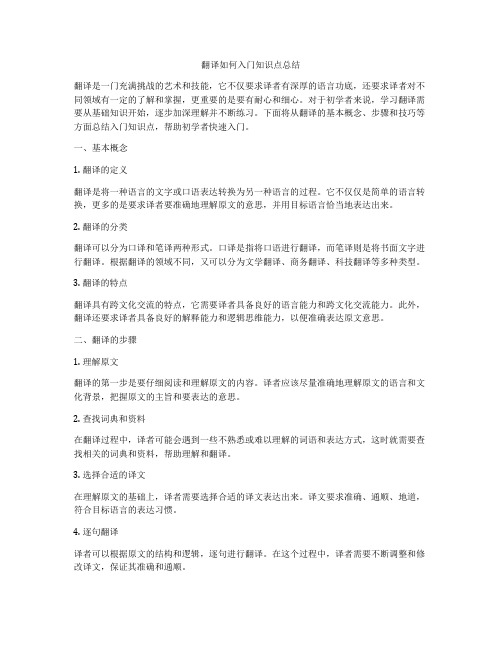
翻译如何入门知识点总结翻译是一门充满挑战的艺术和技能,它不仅要求译者有深厚的语言功底,还要求译者对不同领域有一定的了解和掌握,更重要的是要有耐心和细心。
对于初学者来说,学习翻译需要从基础知识开始,逐步加深理解并不断练习。
下面将从翻译的基本概念、步骤和技巧等方面总结入门知识点,帮助初学者快速入门。
一、基本概念1. 翻译的定义翻译是将一种语言的文字或口语表达转换为另一种语言的过程。
它不仅仅是简单的语言转换,更多的是要求译者要准确地理解原文的意思,并用目标语言恰当地表达出来。
2. 翻译的分类翻译可以分为口译和笔译两种形式。
口译是指将口语进行翻译,而笔译则是将书面文字进行翻译。
根据翻译的领域不同,又可以分为文学翻译、商务翻译、科技翻译等多种类型。
3. 翻译的特点翻译具有跨文化交流的特点,它需要译者具备良好的语言能力和跨文化交流能力。
此外,翻译还要求译者具备良好的解释能力和逻辑思维能力,以便准确表达原文意思。
二、翻译的步骤1. 理解原文翻译的第一步是要仔细阅读和理解原文的内容。
译者应该尽量准确地理解原文的语言和文化背景,把握原文的主旨和要表达的意思。
2. 查找词典和资料在翻译过程中,译者可能会遇到一些不熟悉或难以理解的词语和表达方式,这时就需要查找相关的词典和资料,帮助理解和翻译。
3. 选择合适的译文在理解原文的基础上,译者需要选择合适的译文表达出来。
译文要求准确、通顺、地道,符合目标语言的表达习惯。
4. 逐句翻译译者可以根据原文的结构和逻辑,逐句进行翻译。
在这个过程中,译者需要不断调整和修改译文,保证其准确和通顺。
5. 校对和修改翻译完成后,译者需要进行校对和修改。
通过反复比对原文和译文,检查是否有疏漏和错误,保证译文的准确性和通顺性。
三、翻译的技巧1. 保持灵活翻译过程中,译者需要保持灵活的思维和表达方式。
有时候原文的表达方式可能与目标语言有所差异,译者需要灵活运用语言,使译文更为贴切和地道。
2. 注意语言的风格不同的文体和不同的领域有不同的语言风格,在翻译过程中,译者需要注意语言的风格和用词习惯,力求表达出与原文相同的语言特点。
翻译考点归类

翻译考点归类一、词汇翻译词汇翻译是翻译考试中的常见考点之一。
在理解文本的基础上,准确地翻译词汇是确保翻译质量的关键。
1. 同义词翻译同义词翻译要求我们准确把握原词的含义,并寻找与之相对应的目标语言词汇。
例如,在英汉翻译中,"happy"可以翻译成"快乐"、"高兴"等,在具体情境中选择适当的译词非常重要。
2. 词性转换有时候,原文中的一个名词需要翻译成一个动词,或者一个形容词需要翻译成一个副词。
在这种情况下,我们需要将词性进行转换。
例如,"knowledge"是一个名词,在翻译时可以转换成动词"了解"。
3. 习惯用语翻译习惯用语在不同语言中可能有不同的表达方式。
我们需要了解各个语言的习惯用语,并将其准确地翻译出来。
例如,在英语中,"break a leg"意为"祝好运",在翻译时需要采用类似的表达方式。
二、句子翻译除了词汇翻译外,句子的翻译也是翻译考试中的重要内容。
准确地传达原文句子的含义,同时确保语言通顺,是句子翻译的核心要求。
1. 逐句翻译逐句翻译要求我们将原文中的每一个句子都准确地翻译成目标语言。
在翻译过程中,要注意语法结构和语言习惯的差异,避免产生歧义或翻译错误。
2. 句型转换在某些情况下,原文使用了一种句型,而在目标语言中,我们需要使用另一种句型来准确传达原文的意思。
在这种情况下,我们需要将句子进行句型转换。
例如,原文中使用的是被动语态,而目标语言要求使用主动语态。
三、篇章翻译除了词汇和句子翻译外,篇章翻译也是翻译考试中需要注意的内容。
篇章翻译要求我们将整篇文章的意思准确地传达出来,并且保持原文的逻辑和条理。
1. 段落结构每个段落都应该具备明确的主题,并且与上下文有机地衔接。
当翻译文章时,我们需要注意段落结构的合理性,并在语言上保持一致。
2. 衔接词的运用在篇章翻译中,适当使用衔接词可以使文章的逻辑更加清晰。
初中英语翻译知识点总结

初中英语翻译知识点总结一、词义选择与转换在初中英语翻译中,学生首先需要掌握词义的选择与转换。
由于中英文在表达方式和语言结构上存在差异,同一个英文单词在不同的上下文中可能有不同的中文对应词汇。
因此,学生在翻译时要根据具体的语境来确定最合适的词义。
此外,有些英文表达需要转换为中文的表达习惯,如将英文中的被动语态转换为中文的主动语态。
二、句子结构的调整中英文句子结构存在显著差异,中文多为SVO(主-谓-宾)结构,而英文除了SVO结构外,还常用SOV(主-宾-谓)等结构。
在翻译时,学生需要根据目标语言的习惯调整句子结构,确保句子通顺易懂。
例如,英文中的修饰语通常前置,中文则灵活多变,可以前后位置互换。
三、时态与语态的正确运用时态和语态在英语中占据重要地位,而中文表达时往往不那么严格。
初中英语翻译中,学生要学会根据上下文判断并正确运用各种时态,如一般现在时、一般过去时、现在进行时等。
同时,也要掌握主动语态和被动语态的转换,以及在不同情境下的使用。
四、固定搭配与习惯用法英文中存在大量的固定搭配和习惯用法,这些表达在翻译时往往不能直接字面翻译,而应根据其固定的意义进行翻译。
学生需要积累这些搭配和用法,并在翻译实践中不断巩固和运用。
五、连接词的恰当使用连接词在文章中起到承上启下的作用,使得句子和句子之间、段落和段落之间逻辑连贯。
初中英语翻译中,学生要学会使用恰当的连接词,如表示转折的“however”、“but”,表示因果的“therefore”、“because”,以及表示并列的“and”、“as well as”等。
六、文化差异的考量翻译不仅是语言的转换,也是文化的传递。
在初中英语翻译中,学生需要注意中西方文化的差异,避免直译可能带来的文化误解。
有时需要通过增加解释性语句或调整表达方式来使翻译内容更加贴近目标语言的文化背景。
七、综合实践与反思翻译技能的提升需要大量的实践和反思。
学生在翻译时应多尝试,多比较,多总结。
翻译基本理论知识点
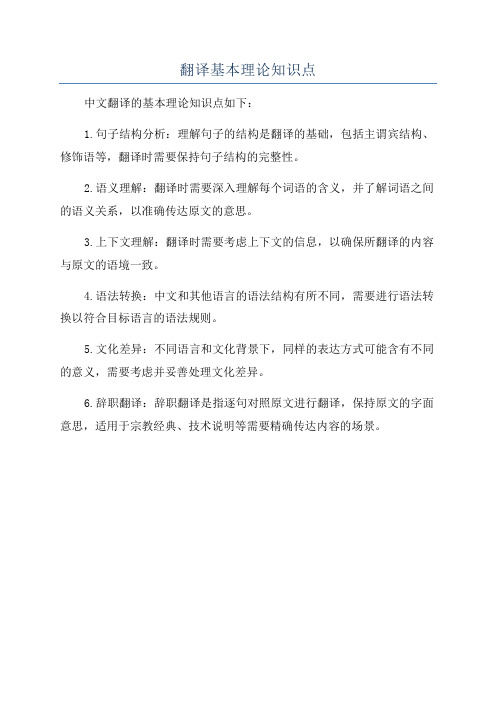
翻译基本理论知识点
中文翻译的基本理论知识点如下:
1.句子结构分析:理解句子的结构是翻译的基础,包括主谓宾结构、修饰语等,翻译时需要保持句子结构的完整性。
2.语义理解:翻译时需要深入理解每个词语的含义,并了解词语之间的语义关系,以准确传达原文的意思。
3.上下文理解:翻译时需要考虑上下文的信息,以确保所翻译的内容与原文的语境一致。
4.语法转换:中文和其他语言的语法结构有所不同,需要进行语法转换以符合目标语言的语法规则。
5.文化差异:不同语言和文化背景下,同样的表达方式可能含有不同的意义,需要考虑并妥善处理文化差异。
6.辞职翻译:辞职翻译是指逐句对照原文进行翻译,保持原文的字面意思,适用于宗教经典、技术说明等需要精确传达内容的场景。
英语翻译常用的十大技巧

英语翻译常用的十大技巧英汉两种语言在句法、词汇、修辞等方面均存在着很大的差异,因此在进行英汉互译时必定会遇到许多困难,需要有肯定的翻译技巧作指导。
下面我就和大家共享英语翻译常用的十大技巧,来观赏一下吧。
英语翻译常用的十大技巧一、增译法指依据英汉两种语言不同的思维方式、语言习惯和表达方式,在翻译时增加一些词、短句或句子,以便更精确地表达出原文所包含的意义。
这种方式多半用在汉译英里。
汉语无主句较多,而英语句子一般都要有主语,所以在翻译汉语无主句的时候,除了少数可用英语无主句、被动语态或“There be…”结构来翻译以外,一般都要依据语境补出主语,使句子完整。
英汉两种语言在名词、代词、连词、介词和冠词的使用方法上也存在很大差别。
英语中代词使用频率较高,凡说到人的器官和归某人全部的或与某人有关的事物时,必需在前面加上物主代词。
因此,在汉译英时需要增补物主代词,而在英译汉时又需要依据状况适当地删减。
英语词与词、词组与词组以及句子与句子的规律关系一般用连词来表示,而汉语则往往通过上下文和语序来表示这种关系。
因此,在汉译英时经常需要增补连词。
英语句子离不开介词和冠词。
另外,在汉译英时还要留意增补一些原文中暗含而没有明言的词语和一些概括性、解释性的词语,以确保译文意思的完整。
总之,通过增译,一是保证译文语法结构的完整,二是保证译文意思的明确。
如:①、What about calling him right away?立刻给他打个电话,你觉得如何? (增译主语和谓语)①、If only I could see the realization of the four modernizations.要是我能看到四个现代化实现该有多好啊!(增译主句)①、Indeed, the reverse is true.实际状况恰好相反。
(增译名词)①、就是法西斯国家本国的人民也被剥夺了人权。
Even the people in the fascist countries were stripped of their human rights.(增译物主代词)①、只许州官放火,不许百姓点灯。
英语翻译常识介绍

因此,在汉语里用含义更为广泛的话题说 明也许要适合得多。由于汉语是注重话题 的语言,常常将说话人想要说明的对象, 放在句子的开头,而将说明部分置于话题 之后,对其进行说明或解释。汉语句子的 主语经常省略,因此汉语有大量的无主句。 例如:Liberty is more important than life. 生命诚可贵,自由价更高。
翻译标准:信、达、雅
Fidelity:不遗漏、不添加、忠实 (relatively) Fluency:通顺流畅、语言规范 (absolutely)
Elegancy:句式地道、语言优雅 (relatively)
翻译步骤
1.Understanding: accurately 2.Expressing: completely 3.Proofing: carefully
2)词序上的差异
英语句中单词修饰语一般放在中心词前面,短语 和从句一般放在中心词后面,汉语定语无论单词 还是词组一般放在中心词前面;英语的谓词状语 一般可出现在动词前后,汉语的谓词状语常在动 词之前;英语中叙述和说明事物时,习惯于从小 到大,从特殊到一般,从个体到整体,从近到远。 汉语的顺序一般则是从大到小,从一般到特殊, 从整体到个体,从远到近,两者顺序完全相反。
Here at home in England, under the fire of the Germany, we do not forget the ties and links unite us to France, and we are persevering steadfastly and in good heart in the cause of European freedom and fair dealing for the common people of all countries, for which, with you, we drew the sword.
- 1、下载文档前请自行甄别文档内容的完整性,平台不提供额外的编辑、内容补充、找答案等附加服务。
- 2、"仅部分预览"的文档,不可在线预览部分如存在完整性等问题,可反馈申请退款(可完整预览的文档不适用该条件!)。
- 3、如文档侵犯您的权益,请联系客服反馈,我们会尽快为您处理(人工客服工作时间:9:00-18:30)。
翻译的基本知识一、翻译的定义奈达:Translation consists in reproducing in the receptor language the closest natural equivalent of the sourcelanguage message, first in terms of meaning andsecondly in terms of style. —— Eugene A. Nida二、翻译的标准奈达:The receptors of a translation should comprehendthe translated text to such an extent that they canunderstand how the original receptor must have understood the original text.——Eugene A. NidaEugene A. Nida (November 11, 1914 – August 25, 2011)was the developer of the dynamic-equivalence Bible-translation theory.四、翻译的方法1 . 直译(Literal translation)例子: C.O.D. (cash on delivery) 货到付现blue chip 蓝筹股一箭双雕hit two hawks with one arrow意译(Free translation)例子:WPA 水渍blue chip 绩优股一箭双雕kill two birds with one stone一、广告的定义Advertising is the non-personal communication ofinformation usually paid for and usually persuasive innature about products, services or ideas by identifiedsponsors through the various media.—— American Marketing Association二、广告的分类1.理性广告(Rational ads)情感广告(Emotional ads)三、广告的组成部分1.Headline Subhead Text (body) Logo sloganI’m lovin’ it! (麦当劳)我就喜欢!Good to the last drop. (Maxwell coffee)滴滴香浓,意犹未尽。
Just do it. (耐克运动鞋)只管去做。
We lead, others copy. (Ricoh 复印机)我们领先,别人模仿。
Minolta, finest to put you finest. (美能达相机)第一流的美能达,第一流的你。
I’m More satisfied. (摩尔香烟)摩尔香烟,令我更爱。
Have a Break. Have a Kit-Kat. (奇巧巧克力)轻松一刻,奇巧时刻。
It’s finger-licking good. 吮指回味,其乐无穷。
(肯德基)Let us make things better. 让我们做得更好。
(飞利浦)To lighten the burden of womankind. 我们为女人减负。
(水晶洗衣机)The un-cola, 7-up. 非可乐——七喜。
You are not fully clean until you’re Zestfully clean.干净?用激爽。
(激爽,沐浴产品)Go well, go Shell. 使用壳牌汽油,保您一路不愁。
Born to run. 天生奔驰。
The world leader in oral care. (高露洁)口腔护理,引领世界。
Originality---Integrity---Innovation. (Levi’s)独特——完美——创新。
Small. Smart. Smile.Pentax: See the difference.小巧。
灵便。
微笑。
宾得相机:不一样,就是不一样。
No problems too large. No business too small. (IBM)没有解决不了的大问题,没有不做的小生意。
We take no pride and prejudice. (Time 杂志)傲慢与偏见,均与我们无缘。
汉英句子的结构差异与翻译一、汉英句子的结构差异英语是形合型(hypotaxis)语言汉语是意合型(parataxis)语言“西洋语言是法治的,中国语言是人治的。
”英语句子结构是语法的,汉语句子结构是语义的。
英语句子的基本结构是SV(O)。
2 . 英语多采用静态,汉语多采用动态例1:The meeting was a success. 会开得很成功。
例2:We are short of hands. 我们正缺人手。
英语被动句多于汉语例1:A few years ago, it was thought unusual that programs could be called up by viewers to be displayed on their screens at home.几年前,人们还以为,观众打电话要求……例2:She was asked about 10 questions during the interview. 面试时问了她十来个问题。
4 . 英语多复合长句,汉语多简单短句。
例:I took it for granted that there would be plenty of graduates in the area who would be willing to work for a joint-venture like ours. 我想当然地以为,这地区会有大量的大学毕业生,愿意为我们这样一家合资企业工作。
5.英语多头轻脚重(孔雀尾),汉语多头重脚轻(狮子头)例:揭穿这种老八股、老教条的丑态给人民看,号召人民起来反对老八股、老教条,这就是五四运动的一个极大功绩。
A tremendous achievement of the May 4th Movement was its public exposure of the ugliness of old stereotype and the old dogma and its call to the people to rise against them.6 . 英语重时态,汉语轻时态。
例:What are you doing? What were you doing at this time yesterday? 你在干什么?昨天这个时候,你在干什么?7.英语常用间接肯定与否定,汉语常用直接肯定与否定。
例1:I can’t agree w ith you more. 我非常赞同你的意见。
例2:We found the quality of the goods below the standard.我们发现这些产品的质量没有达标。
8 . 英语多用代词,汉语少用代词。
例:He hated failure; he had conquered it all his life, risen above it, and despised it in others.他讨厌失败。
他一生中曾战胜失败、超越失败,并且藐视别人的失败。
三、企业名称的翻译1.音译法例:ASEM China Co., Ltd. 阿塞姆洁具贸易(中国)有限公司Ford Motor Company 福特汽车公司Bayer China Co., Ltd. 拜耳中国有限公司Dow Corning (Shanghai) Co., Ltd. 道康宁(上海)有限公司William Grant & Sons Ltd. 威廉·格兰特父子有限公司Midland Bank 英国米兰银行2. 直译法例:Gulf Oil Corporation 海湾石油有限公司Nippon Electric Company 日本电气公司International Business Machines Corporation 国际商用机器公司3.历史沿用法例:First National City Bank 花旗银行Hongkong & Shanghai Banking Corporation 汇丰银行Imperial Chemical Industries 卜内门化工公司3. 音义结合法例:EasyJet 易捷航空公司Goodyear Tire & Rubber 固特异轮胎橡胶公司Benz 奔驰P&G 宝洁公司直接引用法例: A. O. Smith A ·O ·史密斯公司IBM (China)IBM (中国)一、英语成语翻译技巧借用法例1:Kill the goose that lays the golden eggs得寸进尺例2:Give him an inch and he'll take an ell杀鸡取卵例3: a rat in a hole瓮中之鳖直译法例1:to show one’s cards put / lay (one's) cards on the table 摊牌例2:at a snail’s pace 蜗牛般的速度例3:like a fish out of water 如鱼离水例4:in one ear and out the other 左耳进,右耳出例4:strike while the iron is hot 趁热打铁3.意译法例1:by hook or by crook不择手段例2:as poor as a church mouse 一贫如洗3:wolf in sheep's clothing 披着羊皮的狼例4:put all one's eggs in one basket 孤注一掷汉语联合式四字成语的英译方法(1)同义词交叉搭配的成语通常只需译出其中一组的意思。
例如:兵荒马乱turmoil of war愁眉苦脸gloomy face(2)反义词交叉搭配的成语通常前后两部分都要译出。
例如:貌合神离appear united outwardly but divided at heart 深入浅出explain the profound in simple terms(3)同义词和反义词搭配的成语有时只需译出一个部分,有时需要将前后两个部分都译出。
